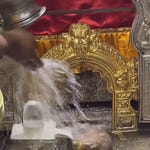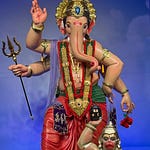High in the lush hills of Solan district, Himachal Pradesh, stands a towering tribute to Lord Shiva – Jatoli Shiv Temple, considered the tallest Shiva temple in North India, rising to an impressive height of 111 feet. This extraordinary temple is not just a symbol of spiritual faith but a marvel of Himalayan architecture, religious devotion, and mystic grandeur. Steeped in legends, rituals, and unwavering reverence, Jatoli Shiv Temple is a beacon for devotees seeking divine presence, spiritual upliftment, and inner awakening.
Origin and Historical Foundation
The name "Jatoli" is derived from the word "jata" (matted locks of Shiva). The temple is so named because of the belief that Lord Shiva himself visited this site and meditated here, making it a spiritually charged location. The temple’s architecture represents the symbolic presence of Shiva’s jatas cascading down the mountain slope.
The story of Jatoli Temple is as ancient as it is divine. According to local legends, centuries ago, Lord Shiva took temporary refuge on this very hill. During this divine sojourn, his presence sanctified the land. A natural shivlinga is said to have manifested here, further affirming the location’s spiritual potency. Over time, sages and saints, sensing the energy of Lord Shiva in the area, began meditating in the vicinity.
The modern foundation of the current temple structure was laid in the early 1970s under the spiritual guidance of Swami Krishnananda Paramhansa, a revered saint who dedicated his life to its development. He is said to have meditated at this site and inspired thousands to participate in the grand construction effort. The temple, after decades of meticulous work and spiritual input, was finally completed in the early 21st century, standing tall with divine aura and architectural elegance.
Architectural Grandeur and Temple Layout
Jatoli Shiv Temple is a three-storeyed stone structure built in traditional South Dravidian temple architecture with Northern Indian influences. Its majestic presence atop a hill resembles Mount Kailash, the mythical abode of Lord Shiva.
First Floor – The sanctum sanctorum housing the sacred Shivlinga.
Second Floor – Dedicated to Nandi, the divine bull and vahana of Lord Shiva, facing his master in eternal devotion.
Third Floor – A symbolic gufa (cave) dedicated to deep meditation and spiritual ascension, reminiscent of ancient Himalayan hermitages.
The temple’s towering 111-foot spire is said to signify spiritual ascension through the chakras, culminating in ultimate realization and union with Shiva – the eternal consciousness.
Pujas, Rituals, and Celebrations
Daily rituals begin early morning with Mangala Aarti and continue with abhishekam (ritual bathing of the Shivlinga) using milk, honey, ghee, and water. Devotees chant Shiva Panchakshari Mantra (ॐ नमः शिवाय) and offer bilva leaves, incense, and fruits.
On Mondays, the temple witnesses heightened activity, as Monday is particularly sacred to Lord Shiva. Devotees observe fasts, perform rudrabhishekams, and chant verses from the Shiva Purana.
Mahashivratri, the grand night of Shiva, draws thousands of devotees from across the region and India. All-night bhajans, meditation, and ritualistic worship make the celebration deeply spiritual and transcendent.
What To Do at Jatoli Shiv Temple
Attend the morning aarti and witness the abhishekam of the Shivlinga.
Meditate in the cave section on the upper floor to connect with Shiva’s formless consciousness.
Chant mantras and circumambulate the temple in a peaceful state of mind.
Offer traditional Shiva puja items like bilva leaves, bhasma (sacred ash), datura, and milk.
Speak with the priests or locals to learn the deep-rooted stories and folklore associated with the temple.
Explore the natural surroundings, as the temple is surrounded by lush greenery and panoramic Himalayan views that add to the spiritual serenity.
What Not to Do at the Temple
Do not bring non-vegetarian food or intoxicants near the temple premises. It is strictly forbidden.
Avoid taking photos inside the sanctum sanctorum, unless permitted by the temple authorities.
Maintain silence in meditation zones and do not engage in loud talking or arguments.
Do not wear revealing or inappropriate clothes – traditional attire is encouraged.
Avoid disrespecting local customs, priests, or saints, as the temple is considered a living spiritual center.
Religious and Spiritual Significance
Jatoli Shiv Temple is more than just a physical structure—it is a vibrational center of spiritual energy, often described by yogis and devotees as a Shakti Sthal (power spot). The belief that Shiva meditated here draws thousands seeking clarity, peace, healing, and moksha (liberation).
The Shivlinga enshrined in this temple is considered swayambhu (self-manifested), giving it even greater spiritual power. For many, visiting Jatoli is equivalent to making a journey to Kailash, Lord Shiva’s eternal abode.
Many devotees claim miraculous healings, mental peace, and answers to life’s dilemmas after offering prayers here. The temple, hence, holds a pivotal place in the spiritual journey of thousands, who revisit it as a place of surrender, realization, and grace.
The Mystery of the Cave
One of the most intriguing aspects of the temple is the meditation cave at the top. It is believed that Swami Krishnananda meditated here for years in isolation, and the cave still holds deep spiritual vibrations. Sadhaks who meditate in the cave claim to experience trance-like states and visions.
This mystic cave, reminiscent of ancient rishis’ dwellings, remains a silent witness to intense tapasya (penance) and sadhana, making it one of the most spiritually active spots in the temple.
Travel and Visiting Information
Location: Jatoli Village, Solan District, Himachal Pradesh
Distance: Approx. 7 km from Solan town
Nearest Railway Station: Solan Railway Station
Nearest Airport: Chandigarh Airport (approx. 60 km away)
The road leading up to the temple is well-maintained. A short trek from the vehicle parking area leads to the temple steps, enhancing the pilgrimage feel.
Timings:
Morning: 5:00 AM – 12:00 PM
Evening: 4:00 PM – 9:00 PM
Best Time to Visit: March to June (pleasant weather) and during Mahashivratri
Devotees’ Experience and Life Connection
For Shiva devotees, Jatoli is a tirtha (pilgrimage) that symbolizes divine transformation. Visiting the temple is often described as life-changing—a place where karma melts, sorrows dissolve, and clarity dawns.
It is not just a temple to offer prayers—it is a gateway to the inner self. Many devotees return here year after year, drawn by the aura of the place, the divine energy, and the feeling of timelessness that surrounds Jatoli.
For those walking a spiritual path, it offers an anchor. For the seekers of Shiva, it offers a destination. And for the devoted, it offers darshan of divinity incarnate.
Conclusion: A Temple of Time, Truth, and Transcendence
Jatoli Shiv Temple is not merely a structure of bricks and stones—it is a monument of faith, a sanctuary of ancient wisdom, and a soul-nourishing destination for those yearning to feel Shiva’s presence in their lives.
Its history whispers of meditating sages. Its stones echo mantras of yore. Its rituals open hearts. And its towering shikhara points towards liberation and enlightenment.
In the heart of Himachal’s tranquil hills, Jatoli stands still, silent, sacred—and alive with the pulse of Har Har Mahadev.
Har Har Mahadev! 🕉️ May the blessings of Shiva guide you on your journey of devotion and discovery.










